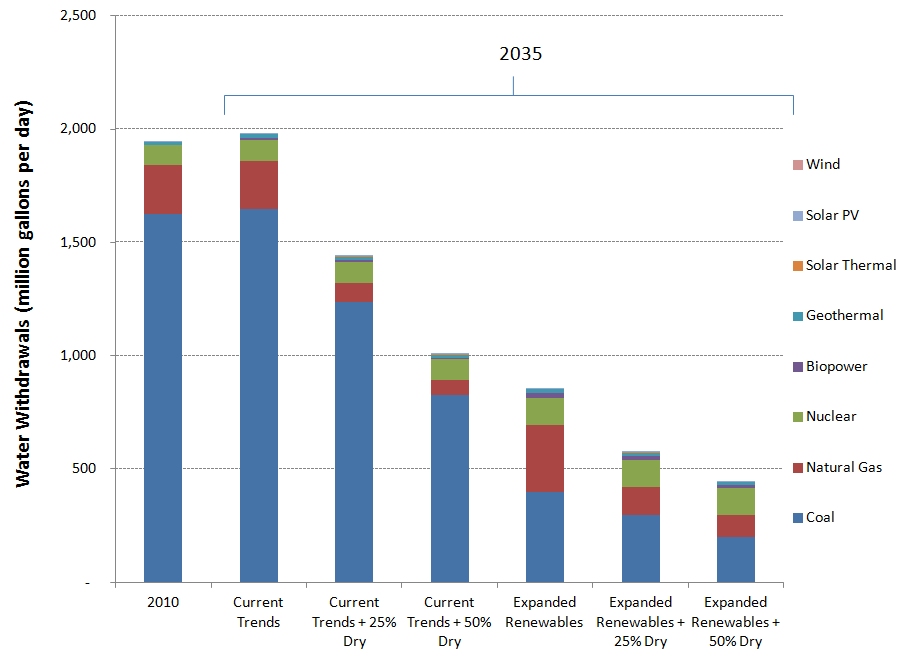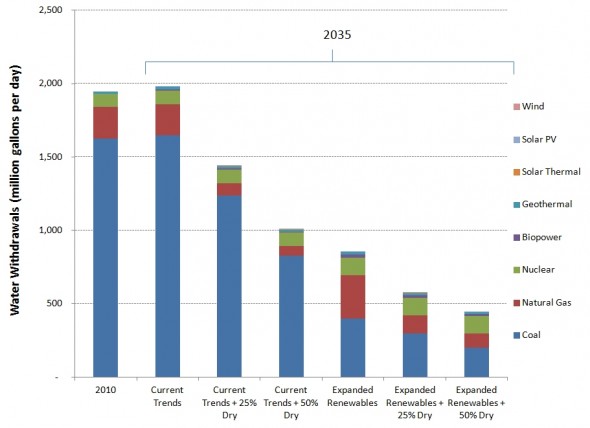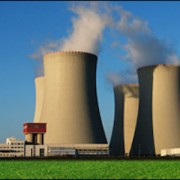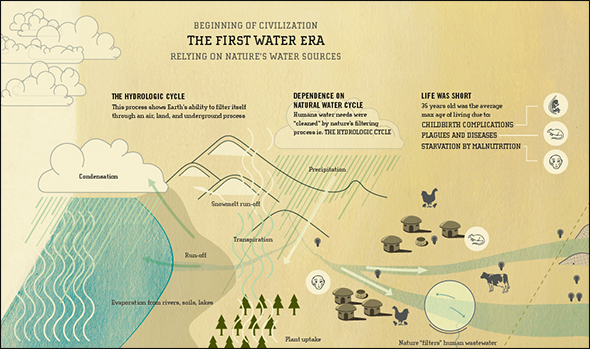Peter Gleick: Energy, Water, and Climate Change in the Western U.S.
A new analysis from the Pacific Institute evaluates the water needs for different energy futures and identifies a growing risk of conflicts between electricity production and water availability in the U.S. Intermountain West. The new report also identifies strategies to ensure the long-term sustainable use of both resources, especially given the realities of climate change. This study is also relevant, given the new intense debate over the Keystone XL pipeline.
Water for Energy: Future Water Needs for Electricity in the Intermountain West, examines the water requirements for current and projected electricity generation within the Intermountain West — the area bounded by the Rocky Mountains in the East and the Sierra Nevada and Cascade Mountains in the West. While water and energy conflicts are increasing across the United States, this region is of particular interest because it has a growing population (and growing demand for energy and water), a diverse fuel mix for power generation, and worsening water constraints and limitations.
The energy sector has a major impact on the availability and quality of the nation’s water resources. Water is used to extract and produce energy; process and refine fuels; construct, operate, and maintain energy generation facilities; cool power plants; generate hydroelectricity; and dispose of energy-sector wastes. Some of this water is consumed during operation or contaminated until it is unfit for further use; often much of it is withdrawn, used once, and returned to a watershed for use by other sectors of society.
Energy use also affects water quality and ultimately human and environment health. The discharge of waste heat from cooling systems, for example, raises the temperature of rivers and lakes, which affects aquatic ecosystems. Wastewaters from fossil-fuel or uranium mining operations, hydraulic fracturing, boilers, and cooling systems may be contaminated with heavy metals, radioactive materials, acids, organic materials, suspended solids, or other chemicals. Nuclear fuel production plants, uranium mill tailings ponds, and under unusual circumstances, nuclear power plants, have caused radioactive contamination of ground- and surface-water supplies. Too often, however, these water-quality impacts are ignored or inadequately understood.
Conflicts between energy production and water availability are on the rise as the overall pressure on scarce water resources intensifies. Federal and corporate policies are being developed with little understanding or concern about the impacts on water resources. In particular, the federal government, through subsidies for corn production, has massively increased the production of ethanol, with little concern for the water supply and quality implications of this policy. Similarly, efforts to promote “clean” coal (a classic oxymoron, in my opinion) have ignored the water-intensity of capturing carbon and other environmental problems. Here are the key issues:
Water scarcity affects energy production. Conflicts between energy production and water are on the rise as the overall pressure on scarce water resources grows. Water availability is beginning to affect energy production, even in areas not traditionally associated with water-supply constraints.
Under a business-as-usual approach, water resource challenges are likely to intensify throughout the Intermountain West.
Under a “current trends” approach, water withdrawals and consumption are projected to increase across the Intermountain West (see the two bars on the left of Figure 1). The largest increases in both withdrawals and consumption occur in the Rocky Mountain area, a region with limited available water sources.
Electricity can be generated in the Intermountain West using less water, especially with the adoption of energy-efficiency improvements and dry cooling systems and greater reliance on renewables. As Figure 1 shows, different energy futures have the potential to be far less water intensive. In particular, significantly expanded renewable energy production and expanded use of alternative cooling technologies cuts water requirements by a vast amount. In the “Expanded Renewables” scenario, water requirements decline dramatically – a 56% reduction in water withdrawals and a 34% reduction in water consumption, compared to 2010 levels. With expanded use of dry cooling systems, even more savings result. Under both an “Expanded Renewables” and “25% Dry Cooling” scenario, water withdrawals and consumption decline 71% and 45% reduction, respectively, compared to 2010 levels.
Extracting fuels for energy production has a water cost that must be evaluated. This analysis also finds that while we can dramatically reduce the water requirements for electricity generation, there are also serious water-related risks from the extraction and processing of coal and natural gas. Extraction processes, such as hydraulic fracturing and tar sands, are both water intensive and increasingly controversial. Indeed, this issue lies at the heart of the debate over the Keystone XL pipeline project and the growing controversies in Pennsylvania and elsewhere over “fracking.”
Climate change will have major implications for water resources and electricity in the Intermountain West. The impacts of climate change on water resources are already evident in the Intermountain West, including changes in precipitation and runoff, an earlier snowmelt, and more frequent and intense droughts. The scientific evidence suggests that these impacts will accelerate, particularly if efforts to reduce greenhouse gas emissions are further delayed. These climate changes will also have major implications for electricity production and use across the Intermountain West, which will, in turn, affect water resources. For example, warmer temperatures reduce the efficiency of thermal power plants and of transmission and distribution lines. More power will need to be generated, and more water withdrawn and consumed, to offset these efficiency losses.
The report closes with a wide range of recommendations.
Improve data, information, and education on impact of energy sector on water resources. Water and energy analysts are often frustrated by the lack of available data on the water use and consumption of energy systems. In a recent report, the Government Accountability Office outlined major shortcomings of federal data-collection efforts on water availability and use as they relate to planning and siting energy facilities. The EIA does not collect data on the use of advanced cooling technologies. No agency collects data on the use of alternative water sources, such as recycled water, for power production. Few data are available on the water-quality impacts of energy production, from energy extraction to generation. Many of these shortcomings are a result of budget cuts. State and federal agencies must enhance, not cut, data collection and reporting capacities.
Accelerate efficiency improvements. Improvements in water and energy efficiency can help meet the needs of a growing population, reduce or eliminate the need to develop capital-intensive infrastructure, and provide environmental benefits. Additionally, conservation and efficiency promote both water and energy security by reducing vulnerability to limits on the availability of these resources.
Promote renewable energy systems. Most renewable systems require far less water than fossil fuel or nuclear systems. Efforts to promote renewable energy will lead to reductions in water demands and contamination.
Establish cooling-technology requirements. Federal and state governments should continue to tighten water-cooling technology requirements through federal and state permitting processes. Power-plant designers must be motivated to further reduce their water impacts by moving to dry and hybrid cooling technologies.
The full report is available here.
Peter Gleick
Originally published by Forbes on November 15, 2011. An exclusive Circle of Blue interview with Heather Cooley, co-author of the Pacific Institute’s new report, is available here: Setbacks and Solutions of Water-Energy Clash in U.S. Intermountain West.









In conversations on this topic, I observe that many interested people are assuming the west coast will meet its human water needs by greater reliance on desalinization. On the surface this is a classic technology-fixing conclusion. On another level, it is a conclusion that assumes there will be sufficient energy to fuel the desalinization plants. When I raise the possibility that concerns with global warming may require that we use less rather than more carbon-based fuels, and that current desalinization technology seems to be energy intensive, I face surprise. Are the teo indeed connected, or am I off base?